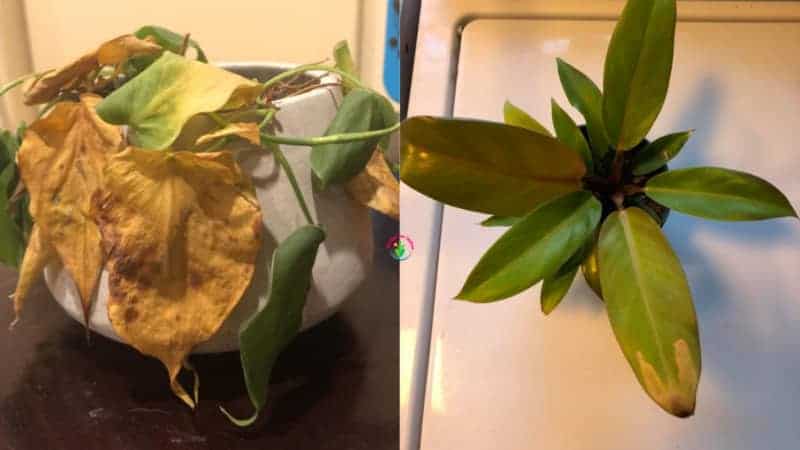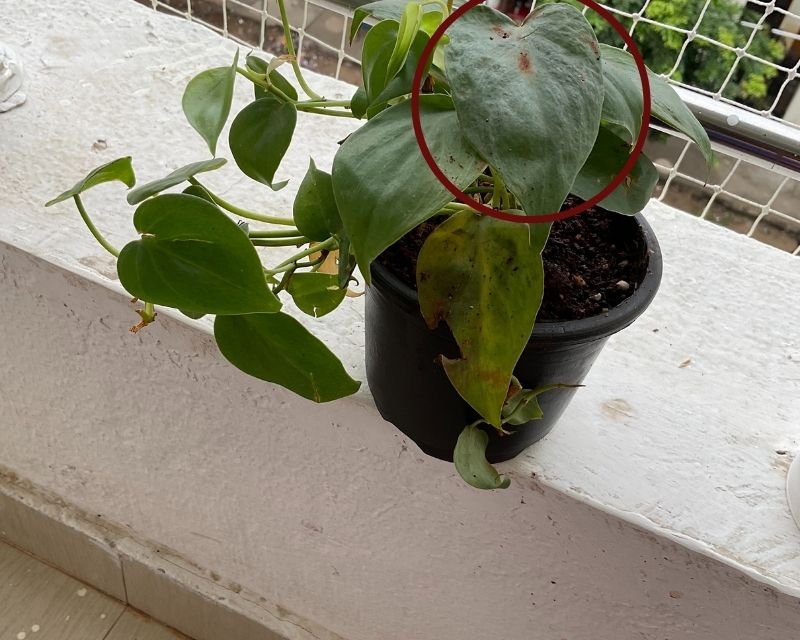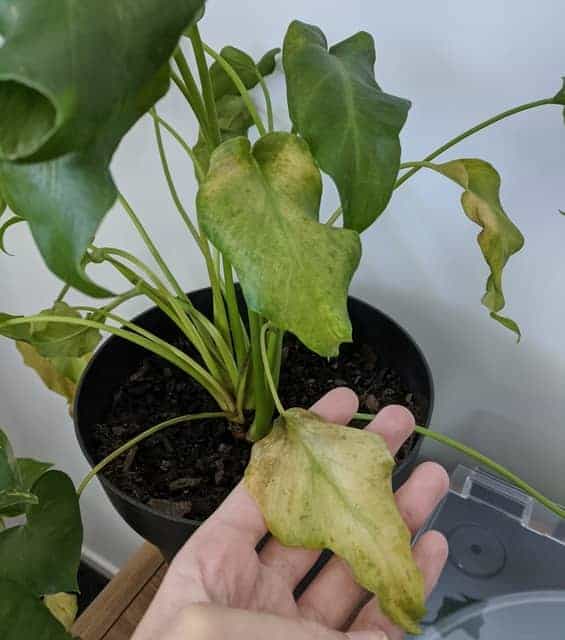
Overwatering and poor drainage lead philodendrons to die because there is too much water surrounding the root ball. Philodendrons need consistently moist soil to flourish. Philodendrons experience root rot in soggy or moist soil, which results in its leaves becoming yellow, drooping, and withering away.
Underwatering, low humidity, too much sun, and temperatures below 50°F (10°C) can cause philodendron leaves to turn brown and droop. They can also die back.
It’s critical to replicate some of the growing conditions of a dying philodendron’s natural environment in your home in order to save it, including evenly moistened soil (but not saturated), routine misting to increase humidity, and placement in an area with bright, indirect light and moderate temperatures.
Continue reading to learn why and how to save your dying philodendron.
Table of Contents
Philodendron Leaves Turning Yellow and Drooping
- Symptoms. Philodendron leaves are becoming yellow, sagging downward, and generally looking dead.
- Causes. The most frequent cause of yellowing and drooping leaves is excessive irrigation. The leaves can also turn yellow from underwatering, frequently with brown leaf edges.
By far, overwatering, slow-draining soils, pots lacking drainage holes at the base, or the use of saucers, trays, and decorative pots underneath the philodendron’s pot—which prevents excess water from escaping—are the most frequent causes of yellowing philodendron leaves.
Tropical plants like philodendron are native to hot, humid locations with abundant rainfall, but significantly, they always flourish in moist but well-draining soil.
If the philodendron is growing in soggy or saturated soil, this restricts root respiration, hinders the roots’ ability to absorb water and nutrients, and results in yellowing and drooping leaves.
It is crucial to solve the problem since root rot can occur if the roots are left in saturated soil for an extended period of time.
How to Save Dying Philodendron with Yellow Drooping Leaves

The only option to salvage a philodendron with root rot is to cut off the diseased root and replant it in fresh soil, although this is a rather harsh measure and the philodendron can still die back from shock.
If you had to replant the philodendron in new soil because of root rot or slow-draining soils, keep the soil moist (but not saturated), as this helps to lessen any transplant shock.
When new growth appears, the philodendron should start to recover; at that time, you can trim back any yellow leaves that have died back.
When you have the right soil profile and the philodendron is planted in a pot with drainage holes so that excess water can drain after watering, you should water philodendrons as frequently as necessary to keep the soil moist. The frequency of watering will vary depending on the climate and conditions in your home, but generally speaking, watering once every week in the winter and fall and one or two times per week during active growth in the spring and summer keeps the plant healthy.
(Read my post, How Often and How Much to Water Philodendrons, for the best watering techniques.)
Keep in mind that the leaves of philodendrons can also turn yellow from inadequate moisture and low humidity, frequently with brown leaf margins…
Philodendron Leaves Turning Brown and Drooping
- Symptoms. Browning of the leaf’s edges or the entire leaf Moreover, leaves may curl or droop.
- Causes. Low humidity, freezing temperatures, underwatering, too much direct sunlight, or other factors.
Philodendrons are indigenous to tropical climes, where they flourish in conditions of moderately high humidity, warm temperatures, regular rainfall, and frequent shade from trees.
The leaves of philodendrons that receive a lot of direct sunlight have a tendency to burn or become brown in spots. Due to drought stress, too much sun can also dry out the moisture from the leaves, causing them to shrivel and turn brown.
In their natural habitat, philodendrons typically grow in relatively high humidity, so if the plants’ leaves are exposed to air conditioning, forced air, draughts, or conventional currents from sources of heat indoors, this can quickly deplete the leaves’ excess moisture before the roots can absorb it, causing the leaves to turn brown as a sign of stress.
Due to the regular rains and high humidity in their natural location, philodendrons thrive in soils that drain well but are equally damp.
The leaves of the philodendron may droop and turn brown, which is a sign of drought stress, if it is not watered frequently enough or is watered too lightly.
Your philodendron may die back in cold temperatures lower than 50°F (10°C). The philodendron prefers a temperature range of 18°C to 30°C, or 65°F to 85°F.
How to Save Dying Philodendron With Brown Leaves and a Drooping Appearance
- Give the philodendron pot a good soak, allowing water to seep out of the drainage holes at the bottom. This guarantees that you irrigated deeply enough to let moisture to reach the roots deeper down in the soil. Only the soil’s top will become moist if you water too little, and the soil’s deeper roots may experience drought stress.
- If necessary, water your philodendron as often as needed to maintain uniformly moist soil (but not saturated). Give the earth a good soak before checking the soil’s wetness by hand for a week to figure out how frequently to water philodendrons. Give the philodendron a thorough soak as soon as the top inch of the soil begins to dry out. This achieves the ideal moisture balance, allowing the plant to get the water it needs without becoming overly damp and developing root rot.
- Twice a week, give the philodendron a light misting. By misting your philodendron, you can create a humid microclimate that closely resembles the higher humidity of the plant’s natural habitat. If the leaves are fading and drooping, keep the philodendron away from drafts and air currents.
- Place the philodendron in direct, strong light at all times. The leaves get scorched-looking brown in areas when exposed to excessive sunshine. As long as you relocate the philodendron from the area of full light to a more shaded place, these scorched leaves do not recover after being sunburned, but they also do not necessarily kill the plant.
- Trim back any sunburned, brown leaves for cosmetic reasons. If the bulk of the philodendron’s leaves are brown from sunburn, however, wait until new growth appears before removing too many leaves because doing so could cause the plant to go into shock and die.
- While the plant is healing, place the philodendron in an area of the house that is between 65°F and 85°F (18°C and 30°C) and stay away from temperatures below 50°F (10°C). Avoid placing your philodendron near a drafty window or in an area of the house where the air is frigid; doing so could result in the plant’s death.
When properly hydrated, philodendrons frequently recover well from a time of drought stress. They should start to show indications of recovery after two or three rounds of watering.
Philodendron not Growing

Although philodendrons are prized for their capacity to grow inside, they require bright, indirect light, and if they are in a shaded environment, their growth can be significantly slowed.
As a plant strives for more light, excessive shade often results in smaller leaves and leggier stalks. Move your philodendron to a room with greater light to encourage further growth.
By sprinkling once or twice per week, you may maintain the soil’s constant moisture and the air’s relative humidity surrounding the philodendrons’ leaves.
Drought stress can cause Philodendrons to cease growing, so it’s crucial to water as regularly as necessary to maintain the potting soil moist (but not saturated) and encourage strong, healthy foliage development.
The roots of a philodendron that has been in the same pot for a long time may become pot-bound and the plant may outgrow it, which could deplete the soil’s supply of nutrients.
To promote the health of your philodendron, repot it in a larger container with fresh soil. The philodendron can get the nutrients it needs to promote growth by using some all-purpose house plant fertilizer.
During the spring and summer, when the plant is actively growing, only feed your philodendron. Philodendrons should typically be fed once a month for optimum growth and health.
Too much compaction of the potting soil around the root ball can exclude oxygen from the soil, preventing root regeneration and interfering with the philodendron’s ability to grow. The philodendron may stop growing as a result of this.
If the soil in your pot is overly compacted, I advise repotting your philodendron using a ratio of 3 parts regular potting soil to 1 part perlite. Perlite contributes to the potting soil’s improved porous structure, which improves water drainage and increases soil aeration for healthy plant growth.
Key Takeaways:
- Overwatering, underwatering, low weather, or too much sun are the causes of a dying philodendron. Due to soggy soil, philodendron leaves yellow and droop, and they also turn brown from not getting enough water or from sunburn. A fading philodendron may be a result of temperatures lower than 50°F.
- Philodendrons are tropical plants that thrive in warm, humid surroundings. For best results, place your philodendron in a room that is between 65°F and 85°F (18°C and 30°C) in temperature. Once or twice a week, mist the leaves to produce a humid microclimate that resembles the philodendrons’ natural habitat.
- To keep the soil evenly moist, water the philodendron as frequently as necessary. Perlite can be added to the potting soil to help with drainage and achieve the ideal moisture balance.
- Locate your philodendron in a location with bright indirect light, moist soil that drains well, mild temperatures, and frequent misting of the leaves if you want to save it. In the active growing seasons of spring and summer, the plant should begin to show indications of healing with the emergence of new growth.
FAQ
Should I cut off damaged philodendron leaves?
If a philodendron plant is taking up too much area in the room or appears long and leggy, it may be useful to prune it back. The best times to prune this way are in the spring or the fall. Any time of year is fine to give your philodendron a little trim to get rid of fading leaves and spindly growth.
How do I bring my philodendron back to life?
Locate your philodendron in a location with bright indirect light, moist soil that drains well, mild temperatures, and frequent misting of the leaves if you want to save it. In the active growing seasons of spring and summer, the plant should begin to show indications of healing with the emergence of new growth.
How does an overwatered philodendron look like?
Wilting leaves are a sign of overwatering. Fresh leaves may become limp and brown. An accumulation of discernible salts on the soil surface is another indicator that overwatering may be the issue. These salts resemble a layer of white, crystalline crust.
Will philodendron leaves grow back?
You certainly can. Even though they don’t need much pruning, philodendron plants occasionally being clipped back maintains these beauties looking their best in the tropics and prevents them from growing too big for their surroundings.
Why are all the leaves falling off my philodendron?
Leaf loss in specific areas may be caused by drafts, either hot or cold, by a lack of light, or by low humidity. Due to the chilly outside air’s limited capacity to hold water vapor, homes become exceedingly dry throughout the winter. When heated, that chilly, dry air causes the indoor relative humidity to fall to Saharan levels.
